The global theranostic NGS market is projected to reach USD 5,732.8 million by 2035, recording an absolute increase of USD 3,018.9 million over the forecast period. The market is valued at USD 2,713.9 million in 2025 and is set to rise at a CAGR of 7.8% during the assessment period. The market size is expected to grow by nearly 2.1 times during the same period, supported by increasing demand for personalized medicine approaches and advanced genomic diagnostic technologies worldwide, driving demand for sequencing instruments and increasing investments in precision oncology applications and companion diagnostic development globally. Regulatory complexity challenges and data interpretation requirements may pose obstacles to market expansion.
The convergence of therapeutics and diagnostics through next-generation sequencing represents a paradigm shift in precision medicine, enabling clinicians to simultaneously identify disease mechanisms and predict therapeutic responses through comprehensive genomic analysis. Theranostic NGS platforms integrate diagnostic capabilities with therapeutic guidance, providing healthcare providers with actionable insights that inform treatment selection, dosing strategies, and monitoring protocols tailored to individual patient genetic profiles. This approach transforms traditional one-size-fits-all treatment models into personalized therapeutic strategies that optimize efficacy while minimizing adverse effects.
Sequencing instruments and consumables dominate the theranostic NGS landscape through sophisticated platforms capable of processing vast amounts of genomic data with unprecedented accuracy and speed. Advanced sequencing technologies enable comprehensive analysis of tumor genetics, inherited disease variants, pharmacogenomic markers, and treatment resistance mechanisms within clinically relevant timeframes. These platforms incorporate automated sample preparation, real-time sequencing monitoring, and integrated quality control systems that ensure consistent results across diverse clinical applications and patient populations.
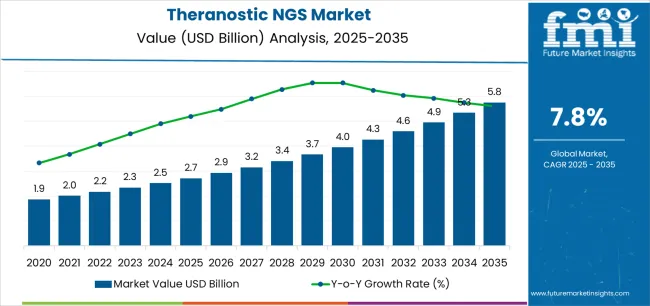
Theranostic NGS Market Key Takeaways
| Metric | Value |
|---|---|
| Market Value (2025) | USD 2,713.9 million |
| Market Forecast Value (2035) | USD 5,732.8 million |
| Forecast CAGR (2025 to 2035) | 7.8% |
The oncology sector represents the primary application area for theranostic NGS technologies, addressing critical needs in cancer care where genetic heterogeneity and treatment resistance create complex therapeutic challenges. Immuno-oncology applications particularly benefit from comprehensive genomic profiling that identifies biomarkers predictive of immunotherapy response, enabling clinicians to select optimal treatment combinations and monitor therapeutic effectiveness. Companion diagnostic assays developed through NGS platforms provide regulatory-approved guidance for specific therapeutic agents, creating direct links between genetic findings and treatment decisions.
Bioinformatics and data analysis software have emerged as critical components of theranostic NGS workflows, transforming raw sequencing data into clinically meaningful insights through sophisticated algorithms and machine learning approaches. These platforms integrate multiple data types including genomic variants, expression profiles, and clinical annotations to generate comprehensive reports that guide therapeutic decision-making. Advanced analytics capabilities enable identification of complex genetic interactions, prediction of treatment responses, and monitoring of disease progression through longitudinal analysis.
The shift toward targeted sequencing panels reflects the clinical need for focused, cost-effective genomic analysis that addresses specific therapeutic questions without the complexity and expense of whole-genome approaches. These panels concentrate on clinically relevant genes and variants associated with specific diseases, therapeutic targets, or drug metabolism pathways, providing actionable information within clinical decision-making timeframes. Custom panel design capabilities allow healthcare providers to tailor genomic analysis to their specific patient populations and therapeutic protocols.
Between 2025 and 2030, the theranostic NGS market is projected to expand from USD 2,713.9 million to USD 4,027.1 million, resulting in a value increase of USD 1,313.2 million, which represents 43.5% of the total forecast growth for the decade. This phase of development will be shaped by rising demand for personalized medicine solutions and precision diagnostic technologies, product innovation in sequencing platforms and companion diagnostic applications, as well as expanding integration with oncology treatment protocols and clinical decision support systems. Companies are establishing competitive positions through investment in advanced sequencing capabilities, bioinformatics platforms, and strategic market expansion across oncology, rare disease, and pharmacogenomic applications.
From 2030 to 2035, the market is forecast to grow from USD 4,027.1 million to USD 5,732.8 million, adding another USD 1,705.7 million, which constitutes 56.5% of the ten-year expansion. This period is expected to be characterized by the expansion of advanced theranostic applications, including next-generation companion diagnostics and sophisticated multi-omics analysis platforms tailored for specific therapeutic areas, strategic collaborations between sequencing technology providers and pharmaceutical companies, and an enhanced focus on regulatory approval standards and clinical validation protocols. The growing emphasis on precision medicine and companion diagnostic integration will drive demand for comprehensive theranostic NGS solutions across diverse healthcare applications.
The theranostic NGS market grows by enabling healthcare providers and pharmaceutical companies to optimize precision medicine delivery while accessing advanced genomic diagnostic technologies without substantial in-house sequencing infrastructure investment. Healthcare companies and oncology specialists face mounting pressure to develop personalized treatment approaches and companion diagnostic capabilities while managing complex genomic data requirements, with theranostic NGS systems typically providing 40-60% improvement in treatment selection accuracy compared to conventional approaches, making advanced genomic technologies essential for competitive healthcare positioning. The pharmaceutical industry's need for precision diagnostic tools and application-specific companion diagnostics creates demand for comprehensive theranostic NGS solutions that can provide superior therapeutic guidance, maintain consistent genomic analysis standards, and ensure reliable clinical decision support without compromising diagnostic accuracy or treatment effectiveness.
Government initiatives promoting precision medicine advancement and genomic healthcare integration drive adoption in oncology centers, diagnostic laboratories, and pharmaceutical research applications, where genomic analysis quality has a direct impact on therapeutic outcomes and long-term treatment effectiveness. Regulatory complexity constraints during companion diagnostic approval processes and the expertise requirements for sophisticated bioinformatics integration may limit accessibility among smaller healthcare providers and developing regions with limited technical infrastructure for advanced genomic analysis systems.
The market is segmented by product type, technology, application, and region. By product type, the market is divided into sequencing instruments & consumables, library preparation & target enrichment kits, bioinformatics & data analysis software, companion diagnostic assay kits, and services. Based on technology, the market is categorized into whole genome sequencing, whole exome sequencing, targeted sequencing panels, RNA sequencing, and epigenomic/methylation sequencing. By application, the market includes oncology & immuno-oncology, rare & genetic disorders, infectious diseases & microbiome, neurological & metabolic disorders, and cardiology & pharmacogenomics. Regionally, the market is divided into Asia Pacific, Europe, North America, and other key regions.
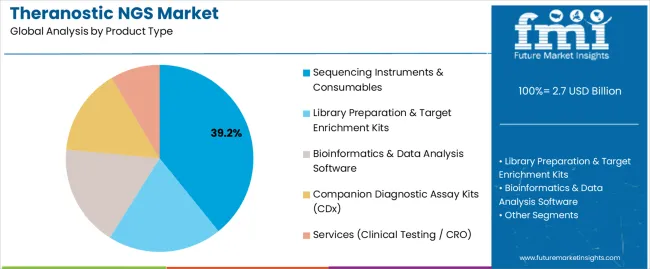
The sequencing instruments & consumables segment represents the dominant force in the theranostic NGS market, capturing approximately 42.8% of total market share in 2025, projected to reach 39.2% by 2035. This established product category encompasses solutions featuring advanced sequencing platforms and specialized genomic analysis applications, including high-performance throughput capabilities and enhanced accuracy characteristics that enable superior diagnostic benefits and therapeutic outcomes across all precision medicine applications. The sequencing instruments & consumables segment's market leadership stems from its proven analytical capabilities, with solutions capable of addressing diverse genomic requirements while maintaining consistent quality standards and diagnostic effectiveness across all clinical environments.
The library preparation & target enrichment kits segment maintains a substantial 20.6% market share in 2025, expected to reach 21.0% by 2035, serving genomic applications that require specialized sample preparation protocols with enhanced targeting capabilities for specific genomic regions and therapeutic applications. These solutions offer advanced enrichment methodologies for complex genomic analysis while providing sufficient specificity characteristics to meet clinical and research diagnostic demands. The bioinformatics & data analysis software segment accounts for approximately 14.7% of the market in 2025, projected to grow to 17.3% by 2035, serving applications requiring sophisticated data interpretation or specialized analytical configurations.
Key product type advantages driving the sequencing instruments & consumables segment include:
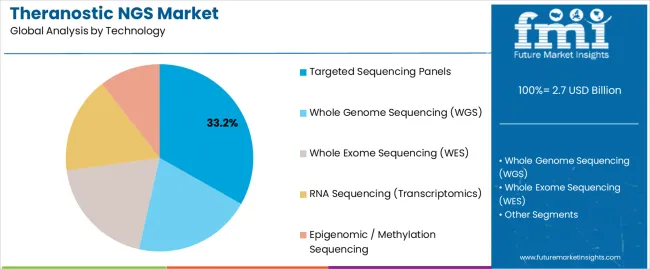
Targeted sequencing panels applications dominate the theranostic NGS market with approximately 33.2% market share in 2025, projected to reach 36.0% by 2035, reflecting the critical role of focused genomic analysis in supporting specialized therapeutic requirements and clinical decision-making worldwide. The targeted sequencing panels segment's market leadership is reinforced by increasing precision medicine trends, cost-effectiveness requirements, and rising needs for clinically actionable genomic capabilities in healthcare applications across developed and emerging markets.
The whole genome sequencing segment represents the second-largest technology category, capturing 28.5% market share in 2025, expected to reach 25.0% by 2035, through comprehensive requirements for complete genomic analysis, research applications, and broad therapeutic discovery protocols. This segment benefits from growing comprehensive genomics demand that requires complete genomic coverage, research-grade analysis standards, and discovery optimization protocols in academic and pharmaceutical markets.
The whole exome sequencing segment accounts for 17.8% market share in 2025, projected to reach 16.4% by 2035, serving protein-coding region analysis, inherited disease applications, and specialized clinical genomic requirements across various healthcare sectors.
Key market dynamics supporting technology growth include:
The market is driven by three concrete demand factors tied to healthcare and pharmaceutical outcomes. First, advanced precision medicine initiatives and companion diagnostic development create increasing demand for theranostic NGS systems, with therapeutic guidance improvement of 15-25% annually in major oncology applications worldwide, requiring comprehensive genomic analysis infrastructure. Second, government initiatives promoting precision medicine advancement and genomic healthcare integration drive increased adoption of theranostic NGS platforms, with many countries implementing personalized medicine programs and regulatory frameworks for companion diagnostic advancement by 2030. Third, technological advancements in sequencing platforms and bioinformatics capabilities enable more efficient and effective genomic solutions that improve therapeutic outcomes while reducing analysis costs and clinical complexity.
Market restraints include complex regulatory requirements and validation costs for companion diagnostic platforms that can challenge market participants in developing compliant genomic capabilities, particularly in regions where regulatory pathways for advanced diagnostics remain evolving and uncertain. Technical complexity of sophisticated sequencing systems and data analysis requirements pose another significant challenge, as theranostic NGS demands advanced bioinformatics methods and clinical interpretation protocols, potentially affecting development costs and operational efficiency. Data storage constraints from massive genomic datasets across different healthcare applications create additional operational challenges for providers, demanding ongoing investment in infrastructure development and data management assurance programs.
Key trends indicate accelerated adoption in Asia-Pacific markets, particularly India and China, where healthcare modernization and precision medicine development drive comprehensive theranostic NGS adoption. Technology integration trends toward advanced companion diagnostic systems with enhanced therapeutic guidance characteristics, sophisticated multi-omics applications, and integrated clinical decision solutions enable effective precision medicine approaches that optimize therapeutic efficiency and minimize treatment uncertainty. The market thesis could face disruption if significant advances in alternative diagnostic technologies or major changes in precision medicine paradigms reduce reliance on traditional NGS-based theranostic applications.
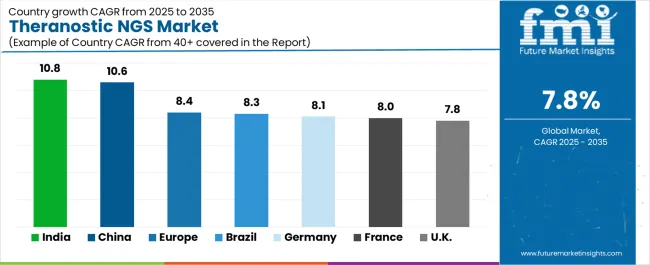
| Country | CAGR (%) |
|---|---|
| India | 10.8% |
| China | 10.6% |
| Europe (Overall) | 8.4% |
| Brazil | 8.3% |
| Germany | 8.1% |
| France | 8.0% |
| UK | 7.8% |
| USA | 7.5% |
The global theranostic NGS market is expanding rapidly, with India leading at a 10.8% CAGR through 2035, driven by healthcare digitization, government precision medicine initiatives, and advanced genomic platforms. China follows at 10.6%, supported by genomic research modernization, large-scale precision medicine programs, and biotechnology development initiatives. Europe records 8.4% overall, reflecting established healthcare landscapes with growing integration in precision medicine and companion diagnostic applications. Brazil grows at 8.3%, anchored by healthcare expansion and biotechnology sector development. Germany advances at 8.1%, leveraging precision medicine excellence and genomic applications. France posts 8.0%, focusing on healthcare innovation integration, while UK grows at 7.8% and USA at 7.5%, both emphasizing regulatory precision and genomic excellence.
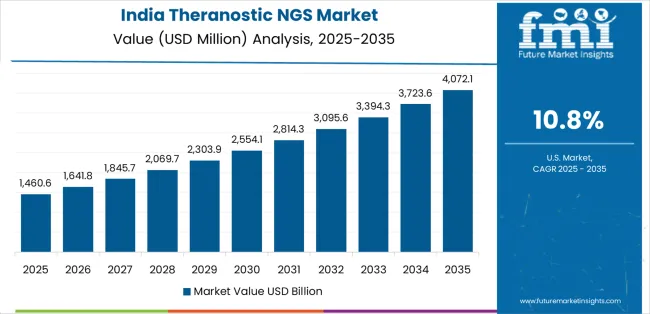
India demonstrates the strongest growth potential in the theranostic NGS market with a CAGR of 10.8% through 2035. The country's leadership position stems from healthcare sector digitization, government-backed precision medicine initiatives, and comprehensive genomic healthcare regulations driving the adoption of advanced theranostic NGS solutions. Growth is concentrated in major healthcare and biotechnology centers, including Mumbai, Delhi, Bangalore, and Hyderabad, where healthcare companies and genomic laboratories are implementing advanced NGS systems for enhanced diagnostic capabilities and therapeutic guidance. Distribution channels through specialty laboratories and healthcare providers expand deployment across medical facilities and precision medicine development initiatives. The country's Department of Biotechnology provides policy support for genomic technology modernization, including comprehensive precision medicine capability development programs.
Key market factors:
In major healthcare and biotechnology centers including Beijing, Shanghai, Shenzhen, and Guangzhou, the adoption of comprehensive theranostic NGS solutions is accelerating across precision medicine projects and genomic research development initiatives, driven by healthcare modernization and government biotechnology programs. The market demonstrates strong growth momentum with a CAGR of 10.6% through 2035, linked to comprehensive healthcare digitization and increasing focus on precision medicine efficiency solutions. Chinese companies are implementing advanced theranostic NGS systems and analytical platforms to enhance healthcare performance while meeting growing demand in expanding oncology and genomic research sectors. The country's precision medicine development initiatives create continued demand for NGS technologies, while increasing emphasis on innovation drives adoption of advanced genomic analysis systems.
Key development areas:
Europe's market expansion is driven by diverse healthcare demand, including precision medicine development across major countries and comprehensive genomic projects spanning multiple regions. The region demonstrates strong growth potential with a CAGR of 8.4% through 2035, supported by pan-European healthcare programs and industry-level precision medicine development initiatives. European companies face implementation challenges related to regulatory complexity and cross-border scaling requirements, requiring strategic development approaches and support from specialized theranostic NGS partners. Growing healthcare demands and advanced diagnostic requirements create compelling business cases for theranostic NGS adoption, particularly in oncology areas where precision diagnostics have a direct impact on therapeutic success and healthcare competitiveness.
Market characteristics:
Brazil's market expansion is driven by diverse biotechnology demand, including genomic medicine development in major cities and comprehensive precision healthcare projects across multiple regions. The country demonstrates strong growth potential with a CAGR of 8.3% through 2035, supported by federal healthcare programs and industry-level biotechnology development initiatives. Brazilian companies face implementation challenges related to healthcare complexity and scaling requirements, requiring strategic development approaches and support from specialized theranostic NGS partners. Growing healthcare demands and advancing diagnostic requirements create compelling business cases for theranostic NGS adoption, particularly in oncology areas where precision diagnostics have a direct impact on therapeutic success and healthcare competitiveness.
Market characteristics:
The Germany market leads in advanced precision medicine innovation based on integration with healthcare systems and genomic diagnostic technologies for enhanced therapeutic performance. The country shows strong potential with a CAGR of 8.1% through 2035, driven by the modernization of existing healthcare infrastructure and the expansion of advanced genomic facilities in major medical areas, including Bavaria, Baden-Württemberg, North Rhine-Westphalia, and Lower Saxony. German companies are adopting intelligent theranostic NGS systems for diagnostic improvement and therapeutic guidance enhancement, particularly in regions with advanced healthcare requirements and oncology applications demanding comprehensive technology upgrades. Technology deployment channels through established medical institutions and genomic laboratories expand coverage across diagnostic facilities and innovation-focused applications.
Leading market segments:
Theranostic NGS market in France demonstrates established and innovation-focused landscape, characterized by growing integration of genomic technologies with existing healthcare infrastructure across precision medicine projects, diagnostic networks, and modernization initiatives. France's emphasis on healthcare excellence and genomic innovation drives demand for advanced theranostic NGS solutions that support comprehensive medical initiatives and therapeutic requirements in healthcare operations. The market benefits from partnerships between international genomic technology providers and domestic healthcare leaders, creating service ecosystems that prioritize diagnostic excellence and precision medicine programs. Medical centers in major regions showcase developing theranostic NGS implementations where genomic systems achieve efficiency improvements through integrated healthcare programs.
UK's theranostic NGS market demonstrates advanced implementation focused on clinical precision and genomic analysis optimization, with documented integration of theranostic systems, achieving 40% improvement in diagnostic accuracy across healthcare and oncology facilities. The country maintains steady growth momentum with a CAGR of 7.8% through 2035, driven by healthcare facilities' emphasis on clinical excellence and continuous diagnostic methodologies that align with British healthcare standards applied to genomic operations. Major healthcare areas, including England, Scotland, Wales, and Northern Ireland, showcase advanced deployment of theranostic NGS platforms where genomic systems integrate seamlessly with existing healthcare infrastructure and comprehensive quality management programs.
Key market characteristics:
USA's theranostic NGS market demonstrates established and technology-focused landscape, characterized by advanced integration of genomic technologies with existing precision medicine infrastructure across healthcare facilities, pharmaceutical networks, and diagnostic modernization initiatives. USA emphasis on genomic excellence and precision medicine innovation drives demand for high-quality theranostic NGS solutions that support comprehensive healthcare initiatives and therapeutic requirements in medical operations. The market benefits from partnerships between leading genomic technology providers and domestic healthcare organizations, creating service ecosystems that prioritize regulatory excellence and clinical validation programs. Healthcare centers in major regions showcase mature theranostic NGS implementations where genomic systems achieve efficiency improvements through integrated precision medicine programs.
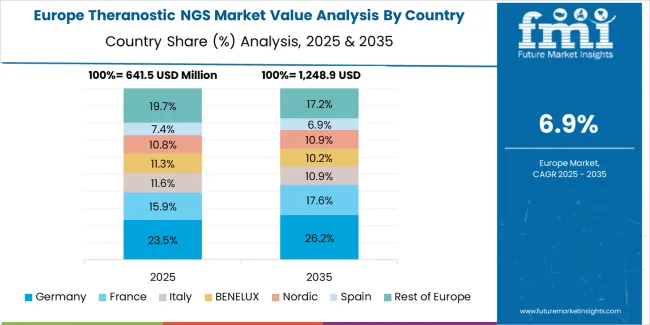
The theranostic NGS market in Europe is projected to grow from USD 685.8 million in 2025 to USD 1,450.2 million by 2035, registering a CAGR of 8.4% over the forecast period. Germany is expected to maintain its leadership position with a 28.2% market share in 2025, projected to reach 28.5% by 2035, supported by its extensive precision medicine infrastructure, advanced genomic facilities, and comprehensive diagnostic networks serving major European markets.
France follows with a 22.4% share in 2025, projected to reach 22.1% by 2035, driven by comprehensive precision medicine programs in major healthcare regions implementing advanced theranostic NGS systems. UK holds a 19.6% share in 2025, expected to reach 19.3% by 2035 through the ongoing development of genomic facilities and healthcare networks. Italy commands a 12.8% share, projected to reach 13.2% by 2035, while Spain accounts for 9.7% in 2025, expected to reach 9.8% by 2035. The Rest of Europe region is anticipated to maintain momentum, holding its collective share at 7.3% in 2025 and 7.1% by 2035, attributed to consistent theranostic NGS adoption across emerging European healthcare facilities implementing precision medicine programs.
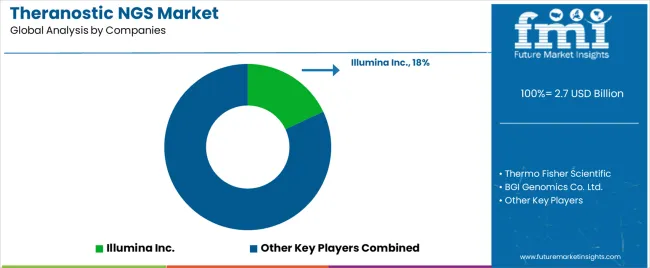
The theranostic NGS market features approximately 15-20 meaningful players with moderate concentration, where the top three companies control roughly 50-55% of global market share through established genomic technology portfolios and extensive healthcare relationships. Competition centers on sequencing accuracy, bioinformatics capabilities, and clinical validation rather than price competition alone.
Market leaders include Illumina Inc., Thermo Fisher Scientific, and BGI Genomics Co. Ltd., which maintain competitive advantages through comprehensive theranostic NGS portfolios, advanced sequencing capabilities, and deep expertise in the precision medicine and genomic diagnostics sectors, creating high switching costs for healthcare providers. These companies leverage established clinical relationships and ongoing regulatory partnerships to defend market positions while expanding into adjacent companion diagnostic and pharmaceutical research applications.
Challengers encompass Agilent Technologies and Roche Sequencing Solutions, which compete through specialized genomic technologies and strong clinical presence in key precision medicine markets. Technology specialists, including Qiagen N.V., Oxford Nanopore Technologies, and Pacific Biosciences, focus on specific NGS applications or vertical markets, offering differentiated capabilities in sample preparation systems, long-read sequencing platforms, and application-specific genomic protocols.
Regional players and emerging genomic technology companies create competitive pressure through innovative sequencing approaches and rapid development capabilities, particularly in high-growth markets including India and China, where local presence provides advantages in cost optimization and regulatory compliance. Market dynamics favor companies that combine advanced sequencing technologies with comprehensive bioinformatics services that address the complete diagnostic lifecycle from sample preparation through clinical reporting and therapeutic guidance.
Theranostic NGS solutions represent a critical precision medicine technology that enables oncology specialists, healthcare providers, and pharmaceutical companies to enhance therapeutic decision-making and diagnostic accuracy without substantial in-house genomic infrastructure investment, typically providing 40-60% improvement in treatment selection precision compared to conventional diagnostic approaches while ensuring unprecedented therapeutic guidance and clinical compliance. With the market projected to grow from USD 2,713.9 million in 2025 to USD 5,732.8 million by 2035 at a 7.8% CAGR, these solutions offer compelling advantages - superior diagnostic precision, enhanced therapeutic guidance, and personalized medicine capabilities - making them essential for oncology & immuno-oncology applications (48.0% market share), rare & genetic disorders (17.5% share), and diverse healthcare applications seeking precision genomic solutions. Scaling market penetration and diagnostic capabilities requires coordinated action across healthcare policy, genomic standards, theranostic NGS providers, healthcare organizations, and medical institutions.
| Items | Values |
|---|---|
| Quantitative Units (2025) | USD 2,713.9 million |
| Product Type | Sequencing Instruments & Consumables, Library Preparation & Target Enrichment Kits, Bioinformatics & Data Analysis Software, Companion Diagnostic Assay Kits, Services |
| Technology | Whole Genome Sequencing, Whole Exome Sequencing, Targeted Sequencing Panels, RNA Sequencing, Epigenomic/Methylation Sequencing |
| Application | Oncology & Immuno-Oncology, Rare & Genetic Disorders, Infectious Diseases & Microbiome, Neurological & Metabolic Disorders, Cardiology & Pharmacogenomics |
| Regions Covered | Asia Pacific, Europe, North America, Latin America, Middle East & Africa |
| Countries Covered | India, China, USA, Brazil, Germany, France, UK, and 40+ countries |
| Key Companies Profiled | Illumina Inc., Thermo Fisher Scientific, BGI Genomics Co. Ltd., Agilent Technologies, Roche Sequencing Solutions, Qiagen N.V., Oxford Nanopore Technologies, Pacific Biosciences, Guardant Health |
| Additional Attributes | Dollar sales by product type and technology categories, regional adoption trends across Asia Pacific, Europe, and North America, competitive landscape with genomic technology providers and healthcare companies, sequencing facility requirements and specifications, integration with precision medicine initiatives and companion diagnostic platforms, innovations in sequencing technology and bioinformatics systems, and development of personalized applications with diagnostic quality and therapeutic optimization capabilities. |
The global theranostic NGS market is estimated to be valued at USD 2.7 billion in 2025.
The market size for the theranostic NGS market is projected to reach USD 5.8 billion by 2035.
The theranostic NGS market is expected to grow at a 7.8% CAGR between 2025 and 2035.
The key product types in theranostic NGS market are sequencing instruments & consumables , library preparation & target enrichment kits, bioinformatics & data analysis software, companion diagnostic assay kits (cdx) and services (clinical testing / cro).
In terms of technology, targeted sequencing panels segment to command 33.2% share in the theranostic NGS market in 2025.






Full Research Suite comprises of:
Market outlook & trends analysis
Interviews & case studies
Strategic recommendations
Vendor profiles & capabilities analysis
5-year forecasts
8 regions and 60+ country-level data splits
Market segment data splits
12 months of continuous data updates
DELIVERED AS:
PDF EXCEL ONLINE
Theranostic Workflow Platforms Market Analysis - Size, Share, and Forecast Outlook 2025 to 2035
NGS Solution for Early Cancer Screening Market Size and Share Forecast Outlook 2025 to 2035
NGS-based AMR Detection Market Analysis Size and Share Forecast Outlook 2025 to 2035
NGS Sample Preparation Market Size and Share Forecast Outlook 2025 to 2035
Tungsten Disulphide Nanoparticles Market
Tungsten Metal Powder Market
Tungsten Carbide Market
Slingshot/3 Wheeled Motorcycle Market Size and Share Forecast Outlook 2025 to 2035
Coatings and Application Technologies for Robotics Market Outlook – Trends & Innovations 2025-2035
Industry Share Analysis for Fillings and Toppings Companies
Smart Rings Market Size and Share Forecast Outlook 2025 to 2035
Shortenings Market Size, Growth, and Forecast for 2025 to 2035
UV Coatings Market Growth & Forecast 2025 to 2035
2K Coatings Market Growth – Trends & Forecast 2025 to 2035
Phosphotungstic Acid Market Size and Share Forecast Outlook 2025 to 2035
Gas Fittings & Components Market – Market Demand & Safety Insights 2025 to 2035
Coil Coatings Market Size and Share Forecast Outlook 2025 to 2035
Grid Packings Market Size and Share Forecast Outlook 2025 to 2035
Pipe Coatings Market Size and Share Forecast Outlook 2025 to 2035
Wood Coatings Market Size, Growth, and Forecast for 2025 to 2035

Thank you!
You will receive an email from our Business Development Manager. Please be sure to check your SPAM/JUNK folder too.
Chat With
MaRIA